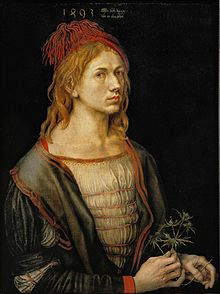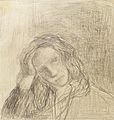Self-portrait

A self-portrait or self-portrait is a self-representation of the physiognomy of a visual artist with the means of painting , graphics , sculpture or photography .
history
The first self-portraits are said to have already existed in antiquity . The famous Greek sculptor Phidias is said to have depicted himself on the shield of the statue of Athena Partenos he created .
Hardly any self-portraits have survived from medieval art; most of them are controversial. Perhaps the oldest preserved are those of John Aquila from the 14th century.
Since the Renaissance, however, the self-confident artist, who was no longer just a craftsman, but considered himself equal to the philosophers, writers and scientists of the time, has set a monument for himself in a self-portrait. In addition to dealing with one's own physiognomy as an omnipresent and cheap model, many self-portraits also testify to the artist's inner confrontation with himself, with his own changing moods and his own transience. The first autonomous artist self-portraits are those by Albrecht Dürer from the end of the 15th century; Jan van Eyck's portrait of a man with a turban from 1433 is controversial as a self-portrait. The earliest artist self-portraits of the Renaissance, however, are not individual pictures, but components of a painted group of people from which only the artist looks out of the picture. Direct eye contact with the viewer has remained a characteristic of most artist self-portraits to the present day.
technology
Apart from the more frequent use of mirrors and photos as templates, the working methods and forms of self-portraits largely correspond to those of other portraits , for example in portrait painting , portrait photography or as portrait busts . In contrast to portraits of strangers, the sides in the self-portrait are often reversed, just as the painter sees his picture in the mirror.
Selection of self-portraits
Filippino Lippi (around 1482)
Leonardo da Vinci , self-portrait as an old man (around 1512)
Rembrandt van Rijn (1630)
Artemisia Gentileschi (1638–1639)
Anton Graff (1765)
Joseph Ducreux , self-portrait (yawning) (1783)
Elisabeth Vigée-Lebrun (1790)
Ilja Efimowitsch Repin (1878)
Vincent van Gogh (1886-1887)
Lovis Corinth , self-portrait with skeleton (1896)
Paula Modersohn-Becker , (1907)
Pierre-Auguste Renoir (1910)
Ilka Gedő self-portrait (1948)
See also
literature
- Julian Bell (ed.): Five hundred self-portraits . Phaidon Press, London 2000, ISBN 0-7148-9139-8 . (Self-portraits by visual artists from ancient Egypt to the present day)
- Pascal Bonafoux, David Rosenberg: Moi! Autoportraits you XX e siècle . Musée du Luxembourg (Paris) / Skira Editore (Milano) (ed.), Exhibition cat. March 31 - July 25, 2004. Paris 2004, ISBN 88-8491-854-5 . (French; The volume introduces 155 visual artists of the 20th century in their self-portraits, each with detailed accompanying texts)
- Frances Borzello: How women see themselves - self-portraits from five centuries . Karl Blessing Verlag, Munich 1998, ISBN 3-89667-052-2 . (The volume is supplemented by notes, short biographies, selected bibliography, list of illustrations and indexes)
- Omar Calabrese: The Story of the Self-Portrait . Deutscher Kunstverlag, Munich 2006, ISBN 3-7774-2955-4 .
- Ludwig Goldschneider: Five hundred self-portraits from antiquity to the present (sculpture, painting, graphics) . Phaidon-Verlag, Vienna 1936.
- Ulrich Pfisterer, Valeska von Rosen (ed.): The artist as a work of art. Self-portraits from the Middle Ages to the present . Reclam, Stuttgart 2005, ISBN 3-15-010571-4 . ( Review )
- Kathrin Schmidt (Ed.): Annegret Soltau - myself , Mathildenhöhe Institute, Darmstadt 2006, ISBN 3-935062-06-0 .
- Ernst Rebel: Self-portraits , Taschen, Cologne 2017, ISBN 978-3-8365-3706-3
- Andreas Beyer : The portrait in painting. Hirmer, Munich 2002, ISBN 3-7774-9490-9 .
Web links
- Ulrike Ritter: Self-portraits ... or »Nobility obliges«: the most stubborn genre. (Part 1) , (Part 2) . Retrieved November 3, 2010












